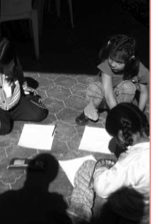Feminicide in Guatemala
The last time Claudina communicated with her parents was around 11:45 p.m. on August 12, 2005. Around 2 a.m. on August 13, Zully Moreno, the mother of Claudina’s boyfriend Pedro Samayoa Moreno, went to Claudina’s Guatemala City home to inform the parents that Claudina was in grave danger. Moreno claimed that Claudina called her to tell her she was walking home and that this call was cut short by Claudina’s screams for help. Claudina’s parents immediately went out to look for their daughter.
When their search turned up no results or leads, the desperate parents attempted to make a report at the local police station at about 3 a.m. on August 13. The police, however, refused to take a report or even listen to the worried parents. They suggested that Claudina had run off with her boyfriend and that, in any case, they would not receive any reports until Claudina had been officially missing for 24 hours. It was not until 8:30 in the morning that the police formally received Claudina’s parents and made an official report that classified Claudina Isabel Velásquez Paiz as missing. This was three and one-half hours after her lifeless body was found on the street in Colonia Roosevelt in Zona 11—a neighborhood not more than two miles from the party where she was last seen by friends. Still, she was not identified until much later that day.
In fact, Claudina’s case was dismissed from the moment her body was found because, as one official acknowledged, “the crime scene was not developed as it should have been because of prejudices about the social origin and status of the victim. She was classified as a person whose death did not merit investigation.” The first police officers on the scene determined that Claudina’s murder was “not worthy” of investigation because she had a belly button ring and was wearing sandals. To the Guatemalan police this indicated she was a gang member or a prostitute.
In fact, Claudina Isabel Velásquez Paiz was a 19-year-old law student, gregarious and well liked by her peers. More than 1,000 people attended her memorial service. Her father, Jorge Velásquez, did not understand what was happening when several armed police officers in uniform arrived at the memorial service and demanded access to his daughter’s cadaver. When Velásquez refused, the police threatened to arrest him and his wife. The coffin was removed from the memorial service and placed in a private room where police officers unceremoniously took finger prints and nail clippings from the body in the coffin. When they were finished collecting this material for forensic analysis, they handed Mr. Velásquez a paper bag. In response to his dismay, the officer explained that the bag contained the clothing Claudina had been wearing at the time she murdered. “Most families bury the clothing in the coffin,” the police explained.
Claudina was one of 518 women murdered in 2005. Each year it is more dangerous to be a woman in Guatemala. Between 2001 and 2006, while the female population increased by 8 percent the female homicide rate increased by more than 117, according to a 2007 study by UN Rapporteur Philip Alston. Nearly 40% of these murders happened in or near Guatemala City. Most of the women who are killed are between 16 and 30 years old. Indeed, the mortality rate of women in peacetime Guatemala today is reaching the very high levels of female mortality in the early 1980s at the height of the genocidal war that took 200,000 lives.
Alston points out, “the death toll is only the beginning of the cost, for a society that lives in fear of killing is unable to get on with its life and business in the ways that it wants.”
FEMINICIDE AND IMPUNITY
What is feminicide and how does it help to explain the phenomenon? The concept of feminicide builds on the term femicide which refers to the murder of women in criminology literature and also to hate crimes against women in the emerging feminist literature addressing the murder of women. (See Russell, Diana and Roberta Harmes, Eds. 2001. Femicide in Global Perspective. New York: Teachers College Columbia University Press.)
Feminicide is a political term. Conceptually, it encompasses more than femicide because it holds responsible not only the male perpetrators, but also the state and judicial structures that normalize misogyny. Feminicide connotes not only the murder of women by men because they are women, but also indicates state responsibility for these murders whether through the commission of the actual killing, toleration of the perpetrators’ acts of violence, or failure to ensure the safety of its female citizens. In Guatemala, feminicide exists because of the absence of state guarantees to protect the rights of women. Impunity, silence and indifference each play a role in feminicide.
In the 1980s, thousands of women were subjected to sexual violence and torture prior to being assassinated by state agents. The Commission for Historical Clarification confirmed that the state trained its soldiers and other armed agents to rape and terrorize women. During the war, army soldiers and other security officers were responsible for 99 percent of acts of sexual violence carried out against women.
These state-trained killers and rapists are free to this day. If the state continues to protect these killers and rapists, then why we would expect them to search out the murderers of Claudina Isabel Velásquez Paiz or any of the other women who have been killed?
Victoria Sanford (Bunting Peace Fellow 1999-2000) is the author of Buried Secrets: Truth and Human Rights in Guatemala and Violencia y Genocidio en Guatemala. Her latest book La Masacre de Panzós – Etnicidad, tierra y violencia en Guatemala will be published this winter in Guatemala. She is currently writing The Land of Pale Hands – Feminicide and Impunity in Guatemala. She is an Associate Professor of Anthropology at Lehman College, City University of New York.
Related Articles
Salvadoran Youth, Transnationalism’s Other Product
English + Español
A completely distraught junior high school teacher in the Washington DC area approached her assistant principal—a highly-educated white middle-class man—one morning for urgent…
Cuba on the Edge: Short Stories from the Island
If you want to read contemporary Cuban fiction and do not have access to the Spanish original, an increasing number of excellent translations will now allow you to become acquainted with…
Making A Difference: Literacy in Calca
Seated on the floor of their school house twenty attentive first grade eyes watch as Martha turns the pages and asks aloud about the fate of David a friendly llama…





